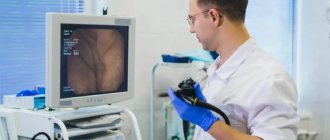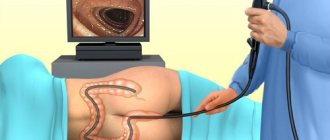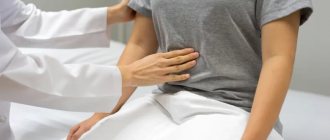Colonoscopy is a minimally invasive diagnostic study of the mucous membranes (inner walls) of the final sections of the intestine (colon). This procedure involves inserting a special flexible endoscopic probe (colonoscope) into the patient's colon through the anus. The colonoscope itself is a thin flexible tube with a diameter of 1 cm and a length of approximately 1.5 m with a small light bulb and a micro-camera at the end. Used to identify diseases of the colon that cannot be detected by other methods or to confirm the diagnosis when a neoplasm is suspected. This study is highly informative and accurate.
Colonoscopy: indications for:
- Differential diagnosis of inflammatory and tumor processes, determining the prevalence and type of pathological changes in the intestine;
- Nonspecific ulcerative colitis;
- Crohn's disease;
- Rectal bleeding;
- Pain in the intestines without an established cause, accompanied by flatulence;
- Prolonged diarrhea with the impossibility of making an accurate diagnosis;
- Foreign body in the rectum;
- Acute intestinal obstruction;
- Constipation;
- Suspicion of the formation of polyps in different parts of the gastrointestinal tract or tumors;
- Endometriosis, ovarian and uterine tumors;
- Anemia of unknown origin,
- Everyone over 50 should have a colonoscopy, especially if they have a family history of gastrointestinal cancer or Crohn's disease.
- Colonoscopy also allows you to perform a number of endoscopic interventions - removal of intraluminal polyps, stopping intestinal bleeding, restoring intestinal patency when pathological narrowings (stenoses) are detected, and removing foreign objects.
- During the examination, a video recording, photographs, and biopsy (tissue removal for further examination) are available.
In order to avoid serious consequences and complications after colonoscopy, the examination should be prescribed strictly according to the doctor’s indications and taking into account the degree of risk of all existing contraindications.
What is a colonoscopy
The essence of colonoscopy is to study the condition of the inner walls of the intestine. The study is carried out using a thin, soft fiber colonoscope or an optical probe with a miniature video camera. The flexibility of the device allows you to examine all anatomical curves. The length of the colonoscope is 1.6 m.
Why is a colonoscopy needed? The study is carried out for early diagnosis of diseases of the blind, colon, rectum, and monitoring the effectiveness of therapy.
What is assessed during the study:
- Color of the mucous membrane. Normally it is pale yellow or pale pink. Changes in color occur due to inflammation or erosion.
- Shine of the mucous membrane. Normally it reflects light well. Dullness appears when the amount of mucus decreases, which indicates the development of pathological processes.
- Surface condition. Normally, the mucosa is smooth, with small folds. In diseases, ulcerations and protrusions are detected.
- Vascular drawing. The absence or strengthening of the pattern of branched small arteries occurs with swelling of the submucosal membrane.
- Mucosal overlays. Normally there are small spots or lumps. In diseases, the deposits thicken, and impurities of fibrin, necrotic tissue, and purulent contents appear.
One of the advantages is that during the examination you can take tissue for a biopsy and remove polyps, tumors or foreign bodies. During the study, intestinal bleeding is stopped and intestinal patency is restored in case of stenosis.
The main contraindications for colonoscopy include:
- Acute infections of the rectum, as well as acute infections of the body of any location;
- Intestinal perforation;
- Crohn's disease and nonspecific ulcerative colitis in acute form;
- Peritonitis;
- Pathologies of the blood coagulation system;
- Ulcerative or ischemic colitis in severe form, associated with the risk of bleeding or perforation of the intestinal wall;
- Severe chronic heart and pulmonary failure;
- Stroke;
- Anal fissures, exacerbation of hemorrhoids, paraproctitis, thrombosis of hemorrhoids.
- Large hernias;
- State of shock.
To prevent complications after a colonoscopy, the patient needs to prepare properly. The patient is carefully examined for concomitant diseases and contraindications that may complicate the procedure and the recovery process after it.
Preparing for intestinal colonoscopy
Before undergoing a colonoscopy, you will need to undergo an important bowel preparation process, which includes the following steps:
- Following a special slag-free diet 5-7 days before the procedure;
- On the eve of the procedure, patients are advised to drink at least 3.5 liters of water;
- Abstain from food and water 12 hours before the procedure;
- Carrying out a cleansing enema in the evening and morning before the procedure to increase its effectiveness. The volume of the enema must be at least 1.5 liters; it is administered until only clean water begins to come out;
- Conducting allergy tests to identify allergies to anesthesia drugs.
- In some cases, on the eve of the study, the patient may be offered to take special laxatives, which are selected by the doctor individually for each patient.
If the patient follows these simple recommendations, the risk of undesirable consequences after the procedure is minimal. There is also no need to use painkillers or local anesthesia. In some cases, a so-called “colonoscopy under anesthesia” - during the procedure the patient is immersed in a medicinal sleep (therefore, this version of the procedure is also called “ sleep colonoscopy ” ), and immediately after it wakes up. Colonoscopy under anesthesia is performed at the request of the patient if he is too afraid of pain, or when a polyp will be removed or a biopsy taken at the same time as the diagnosis.
One of the most common complications is injury to the intestinal walls. Therefore, an effective diagnostic colonoscopy must be performed by an experienced, qualified specialist in compliance with all the rules for conducting this endoscopic procedure and sanitary and hygienic standards to prevent infection.
Diet after intestinal colonoscopy
After completion of the endoscopic examination, the intestines should resume their normal function. Be prepared that this will take several days. The main place in the prevention of unpleasant consequences of colonoscopy is occupied by proper nutrition and diet.
For quick recovery, frequent split meals are required in small portions. Food must be well digested so as not to burden the intestines. Food products should contain many vitamins, minerals and protein, which allow the body to recover faster after the procedure, and also reduce the risk of infectious complications and intestinal bleeding. Overeating is extremely contraindicated. During the invasive intervention, the mucous membrane of the intestinal walls suffered minor damage, so it is worth paying special attention to taking probiotics to restore the intestinal microflora. Consult with your doctor which drug is best for you to use.
The menu after intestinal colonoscopy during the first days should include such easily digestible dishes as:
- Steamed lean fish (pike perch, hake, pike, cod);
- Cottage cheese with a minimum percentage of fat content
- Natural yogurt
- Kefir and skim milk
- Low-fat soups with vegetable broths
- Eggs
- Vegetables and fruits
avoided after a colonoscopy :
- Alcohol:
- Grilled meat
- Fatty fish
- Semi-finished products, sausages, sausages,
- Smoked meats and pickles
- Fresh pastries, bread and confectionery
- Canned food
- Whole grain porridge
Possible consequences of colonoscopy
The colonoscopy procedure, while accurate and informative, is minimally painful. But unfortunately, during the recovery period after it, patients experience certain unpleasant sensations to varying degrees:
- General malaise.
- Pain in the intestines
- Bloody discharge from the anus
- Flatulence, bloating
- Defecation disorder
The most serious consequences are bleeding in the area of the removed polyp and intestinal perforation.
General malaise, weakness after colonoscopy
In the first hours after the procedure, the patient may experience general malaise, weakness, dizziness, abdominal pain, pain when walking and nausea. These sensations arise due to the fact that the painkillers used during colonoscopy or anesthesia stop working. Also, a state of weakness and nausea can occur due to the fact that a person has not eaten for a long time before and after the procedure - the body requires replenishment of energy and new nutrients. Do not forget about the emotional experiences regarding this examination and the subsequent recovery period. Therefore, after the procedure, the patient is recommended to eat in accordance with the doctor’s recommendations and lie on his side in a relaxed state for several hours. As a rule, these uncomfortable sensations go away on their own within a few days. The following prescriptions can help you regain strength quickly after the procedure:
- To restore the water-salt composition of the blood and relieve intoxication, physiological solutions are administered
- Taking vitamins, especially group B and C - they are necessary to strengthen the immune system and the proper functioning of the nervous and muscular systems.
If you have a fever during the first 24 hours after the examination, then it is possible that some kind of inflammatory process has begun in the intestines, caused by an attached infection. This is a complication in the recovery process after a colonoscopy, you should immediately contact your doctor.
Pain after colonoscopy
The occurrence of pain after colonoscopy is due to the fact that during the procedure the mucous membrane of the colon can be injured by the endoscope itself, as well as stretched under the influence of the introduced air. Therefore, mild pain and discomfort after manipulation can occur in many patients and in itself should not cause concern.
If the pain is pronounced and difficult to bear, then there is a possibility of a complication such as intestinal perforation. The likelihood of such a complication is extremely low and is less than 1%. In this case, in addition to pain, symptoms such as vomiting, persistent rectal bleeding, bloating, or abdominal muscle tension may occur.
If these symptoms worsen, this may indicate peritonitis. In this case, urgent surgical intervention is necessary to restore the colon wall.
Discharge from the rectum after colonoscopy
In some special cases, colonoscopy can provoke bleeding caused by endoscopic biopsy (plucking off a piece of tissue for histological examination) or removal of a polyp using an endoscopic loop, as well as trauma to the intestinal wall up to its perforation.
If the bleeding after endoscopic manipulation is moderate, is not accompanied by pain in the abdomen or anus, and does not cause other discomfort in the form of weakness and dizziness, this is considered normal and will go away on its own after the first two to three days.
But you should seek medical help immediately if you experience the following symptoms:
- The appearance of a significant amount of scarlet blood from the anus;
- A sharp drop in blood pressure;
- Severe pain in the abdominal area
- Rapidly increasing weakness, dizziness and loss of consciousness;
- My heart begins to pound.
All these signs may indicate bleeding in the colon, caused in extremely rare cases by intestinal perforation or injury to the spleen; more often, the area of the removed polyp bleeds. Only with timely hospitalization is it possible to control these complications.
Also, after a colonoscopy, purulent discharge may appear from the anus - this is evidence that an infection was introduced during the manipulation, and inflammation began in the colon. As a rule, this condition is accompanied by general malaise and increased body temperature. It is not recommended to lower the temperature on your own, so as not to blur the symptoms. You need to seek medical help to establish the true cause of the fever and stop the inflammation process by administering antibacterial therapy.
Flatulence, bloating after colonoscopy.
During a colonoscopy, the doctor introduces air into the intestines through an endoscope. This is required in order to straighten the intestinal walls and improve visibility, as well as to facilitate insertion of the endoscope into the rectum. After the procedure, this air remains in the intestines for some time, causing discomfort, a feeling of bloating and flatulence.
These undesirable consequences usually go away on their own. If this does not happen for some time, you can take an enterosorbent (for example, 4-5 tablets of activated carbon).
It should be noted that flatulence and bloating practically do not occur after colonoscopy if CO2 carbon dioxide was used instead of air during the procedure. Unfortunately, a special device called an endoscopic CO2 insufflator (UCR) is not available in all clinics.
Problems with bowel movements after colonoscopy
Since colonoscopy is an invasive method, it causes some trauma to the mucous membrane of the intestinal walls and disrupts its microflora. This intervention affects normal bowel function. Constipation or diarrhea may occur in the first days after the procedure. Blood, pus, or mucus may appear in the stool. Medicines prescribed by a doctor according to the indications that arise will help alleviate the condition.
Constipation occurs as a result of spasm of the intestinal walls. Taking the following laxatives will help relax your muscles.
- Duphalac
- Guttalax
- Forlax
- Regulax
Diarrhea after a colonoscopy occurs due to the fact that during the examination, the process of absorption of water from the stool in the intestines is disrupted, and the feces remain liquid at the exit. The following medications will help alleviate this condition:
- Smecta
- Loperamide
- Hilak
- Decoctions of St. John's wort, bird cherry fruits and blueberries.
If there are any manifestations of disturbances in the process of bowel movement, you must inform your doctor to select the appropriate medications. It is not recommended to take medications on your own, so as not to harm your health.
Colonoscopy – is it painful or not?
Most patients' doubts about the need for a colonoscopy are based on fear of the painful sensations that they are expected to endure. Such different and contradictory reviews about the procedure are due to different pain thresholds and congenital structural features of the gastrointestinal tract.
The examination, as a rule, does not cause significant pain in the patient, and therefore is carried out without anesthesia. Some discomfort may occur when pumping air and passing the colonoscope through intestinal bends, for example, the hepatic and splenic angles of the colon. But these sensations are usually tolerable. If the patient is well prepared, the procedure usually lasts 15-20 minutes.
In patients with adhesive disease of the abdominal cavity, as well as those who have undergone extensive surgery on the abdominal and pelvic organs, the procedure can be very painful and lengthy. In such situations, the examination is carried out under anesthesia.
The endoscopist will inform you about the results of the study immediately after the examination, and when a biopsy is taken, the morphological report will be ready in 8–12 days
You can eat and drink immediately after the procedure, and nutrition after a colonoscopy does not require any restrictions. If the patient still has a feeling of bloating, you can take 10 tablets of activated carbon, previously crushed and dissolved in half a glass of warm water.
Popular publications:
- Black feces Why? Causes? — 01/07/2015 05:06 — Read 45892 times
- Video capsule endoscopy: frequently asked questions - 11/12/2013 17:02 - Read 45,759 times
- Capsule endoscopy. Description, reviews, advantages and disadvantages - 03/24/2013 17:15 - Read 42119 times
- Abdominal syndrome. Abdominal pain - 01/10/2015 05:02 - Read 23554 times
- Capsule colonoscopy - indications, contraindications, price - 10/30/2015 07:20 - Read 19428 times
Key words: Colonoscopy, intestinal colonoscopy, colorectal cancer, colon cancer, polyps, colonoscopy indications, diet during colonoscopy
- < Back
- Forward >
How is the intestines connected to well-being?
The most common symptoms of intestinal dysfunction are united under the collective concept of intestinal dyspepsia. These include bloating, increased gas formation, rumbling in the abdomen, diarrhea, constipation or alternation of constipation (unsteady stools), discomfort and abdominal pain. These symptoms can be caused by an unhealthy lifestyle, long-term use of medications, stress, or insufficient production of digestive enzymes due to the presence of various diseases of the gastrointestinal tract, and in particular the intestines. Constantly recurring symptoms of intestinal dyspepsia cause a deterioration in the quality of life. Therefore, when such symptoms appear and, especially, when they recur frequently, in order to undergo effective treatment and get rid of them, the help of a gastroenterologist is necessary.
Intestinal diseases and disorders can affect various processes in the body and cause symptoms that are not always clearly indicative of the intestines. These include weakness, loss of strength, skin problems, hair loss, low mood, joint pain, they are also called extraintestinal. In addition, the imbalance between normal and pathogenic microorganisms that make up the microflora also affects the well-being and health of a person and can contribute to the development of inflammatory processes in the body.
You can get advice from a gastroenterologist specializing in the diagnosis and treatment of intestinal diseases at the Expert Gastroenterological Center.







